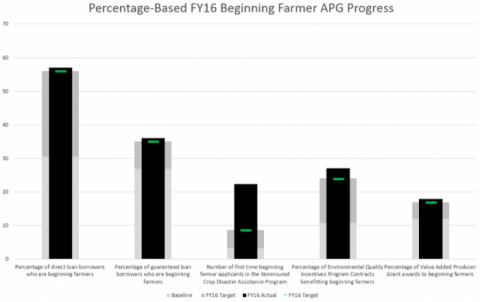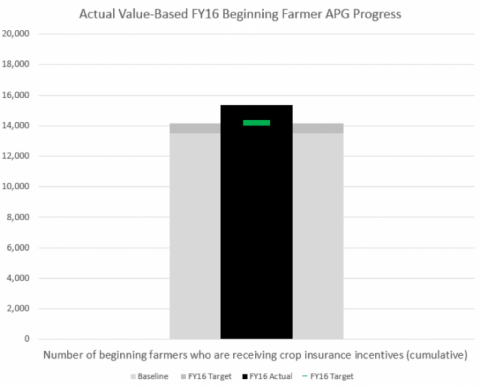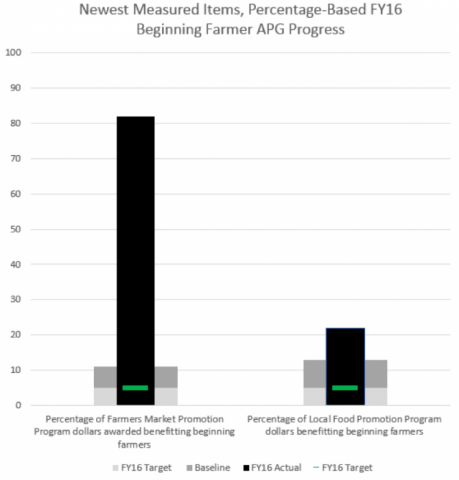- Home
- Agencies
- Department of Agriculture
- Department of Housing and Urban Development
- General Services Administration
- Department of Commerce
- Department of the Interior
- National Aeronautics and Space Administration
- Department of Defense
- Department of Justice
- National Science Foundation
- Department of Education
- Department of Labor
- Office of Personnel Management
- Department of Energy
- Department of State
- Small Business Administration
- Environmental Protection Agency
- Department of Transportation
- Social Security Administration
- Department of Health and Human Services
- Department of the Treasury
- U.S. Agency for International Development
- Department of Homeland Security
- Department of Veterans Affairs
- Goals
- Initiatives
- Programs
Supporting increased access to program participation for new and beginning farmers and ranchers in key USDA programs
What’s the issue?
The most recent Census of Agriculture, showed that the U.S. had 20 percent fewer beginning farmers (principal operators who were on their current operation for ten years or less) in 2012 than in 2007. Furthermore, the average age of principal farm operators is now at 58.3 years old nationwide. Additionally USDA’s 2015 Tenure, Ownership, and Transition of Agricultural Land report, which evaluated the impending transition of agricultural land to the next generation, found that almost 10 percent (or 91 million acres) of all farmland is expected to transition in the next five years, not including the 57.1 million acres that landowners have put or plan to put into wills. These changes in ownership will have a significant impact on the structure of the agricultural economy and rural communities.
What was the intervention?
USDA has engaged its resources and developed a coordinated strategy for strengthening the next generation of farmers and ranchers by improving access to land and capital; building new markets and market opportunities; extending new conservation opportunities; offering appropriate risk management tools; and increasing our outreach, education, and technical support. This effort required integrated, cross-Departmental collaboration to support both initial opportunities for new and beginning farm businesses, as well as resources to ensure their longevity. Under the leadership of Secretary Vilsack, the USDA as well as complementary government and partner resources, are working together to educate the next generation and provide them with relevant programming. This coordinated effort is specifically targeting increased participation in programs which create opportunity and longevity for new and beginning farmers and ranchers, both through supporting initial opportunity, and helping producers plan for and respond to low prices and inclement weather.
How was performance management useful?
The Department has made support for the next generation of farmers and ranchers a high priority since 2009. Strengthening the next generation of farmers and ranchers was identified as a strategic goal in both the Department’s 2010-2015 and 2014-2016 Strategic Plans, and increasing access and opportunity for beginning farmers and ranchers was designated as an Agency Priority Goal (APG) for FYs 2016-2017. While the Departmental programs contributing to this APG were already generating measurable results for new and beginning farmers, the initiative’s elevation as an agency priority provided the senior-level accountability needed to increase the coordination and alignment with the mission of new farmer service. The APG enhanced already good working relations between staff and broke down barriers, leading to a better understanding of common terms, more accurate measurements of beginning farmer impacts, enhanced data tools, shared commitments to customer service, and increased capacity for collaboration between programs. Most importantly, this APG created the opportunity to consider how USDA programs align with the needs of the new farmer community, and whether USDA should be doing more to support the newest members of the agricultural family and their access to USDA’s programming.
What was the impact?
Over the course of the first year of this goal’s administration, USDA has significantly deepened our investment in the next generation of farmers and ranchers, strengthening our overall understanding of these programs’ outcomes and impacts. Accomplishments include:
- A 10 point increase in satisfaction utilizing agency website to gain program information;
- Created a customer service experience baseline; every aspect of customer service was highly rated, including: “courtesy of representatives,” “knowledge of representatives,” “timeliness of responding,” and “degree to which representative made you feel your needs are important.” This baseline will create an important opportunity to grow and improve;
- A few additional examples of our growing body of work in this space since 2009:
- Issued more than 138,000 direct and guaranteed farm operating and farm ownership loans to beginning farmers and ranchers since 2009 - this is of key importance because USDA is often the first line of credit available to new and beginning farmers;
- Issued over 21,700 microloans to help small, underserved, and beginning farmers obtain operating credit; in total, 72 percent of Farm Service Agency’s microloans have gone to beginning farmers;
- Implemented a new microloan program to help farmers with the purchase of farmland, meeting a key ask of customers for faster, more accessible credit, and support during the critical access to land phase;
- Facilitated almost 2,700 contracts to transition over 400,000 acres of expiring conservation reserve program land from retired or retiring landowners to beginning or underserved producers for sustainable grazing or crop production;
- Invested over $1 billion in more than 40,000 local and regional food businesses and infrastructure projects – directly contributing to development and revitalization of infrastructure to support local/regional food systems – a key point of access to opportunity for new farm businesses;
- Made available over $60 million since 2009 to defray the cost of organic certification– a key opportunity for new and beginning farmers and ranchers;
- Expanded offerings of organic price elections from just four crops in 2011 to 73 different crops in 2016, helping new and beginning organic producers better manage risk;
- Strengthened the Noninsured Crop Disaster Assistance Program (NAP) for new producers by reducing the premiums on buy-up level coverage by 50 percent for new farmers and waiving their application fee;
- Awarded over 9,600 EQIP contracts to new and beginning farmers in FY 2016 - nearly $300 million in obligations, or 27 percent of all EQIP contracts; and,
- Supported 17,031 high tunnels since 2010. These low-cost greenhouses extend the growing season, reduce input costs, conserve natural resources and make locally-grown produce available for a greater portion of the year – and can be important tools for new and beginning farmers.
- To see a full review, please visit USDA Results: Beginning Farmers and Ranchers.







